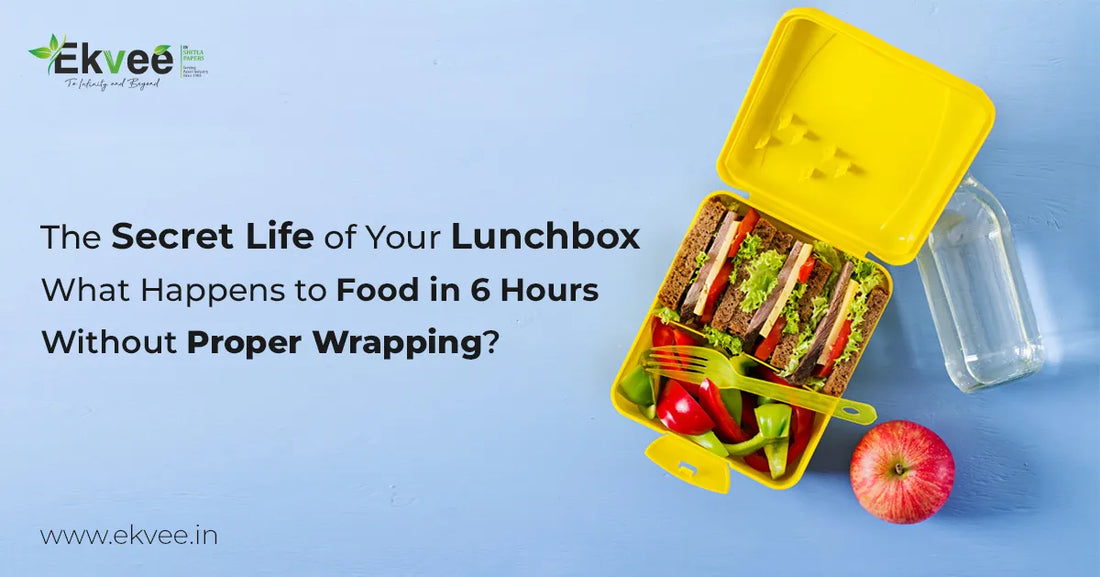
The Secret Life of Your Lunchbox — What Happens to Food in 6 Hours Without Proper Wrapping?
Share
Every morning, we carefully pack lunch, whether it’s soft rotis, cheesy sandwiches, crispy cutlets, or last night’s flavorful paneer sabzi. We hope that by lunchtime, our food will still taste just as good as it did when we packed it. But the reality is, food doesn’t stay the same for six long hours in your lunchbox. It changes. Sometimes it changes slowly, and other times significantly. Most of the time, improper wrapping is the real problem.
So what happens to your food between 8 AM and 2 PM? Let’s explore this hidden journey.
Hour 1, The Steam Trap Begins
Right after packing, your food is still slightly warm. If you don’t wrap it properly, steam gets trapped inside the lunchbox. This steam condenses on the lid and drips back onto your food. The soft paratha that left your kitchen fluffy and fresh becomes limp and moist. At the same time, foods like roti start losing their natural moisture and dry out. The battle between sogginess and dryness begins.
Hours 2 & 3, Aroma Escapes, Odors Invade
In just a couple of hours, the original smell of your food fades. It clings to the inner surface of the lunchbox, robbing your meal of its appealing aroma. Meanwhile, different items start sharing moisture and smells. Your aloo paratha suddenly smells like pickle. Your sandwich absorbs the masala scent of nearby sabzi. The flavors mix and confuse your taste buds.
Hour 4, Bacteria Enter the Scene
Even if your lunchbox is washed daily, it isn’t sterile. As food sits in a semi-warm, moist environment, microorganisms begin to multiply. Food safety experts warn that cooked food at room temperature for more than four hours enters the danger zone. This means the food may look okay, but it might already be unsafe to eat. If not wrapped securely, food invites bacterial growth.
Hours 5 & 6, Texture Destroyed, Nutrition Lost
By the time lunch hour arrives, your food has changed. The roti that was soft in the morning is now leathery and chewy. The sandwich that looked crisp is now sticky and soggy. That crispy pakoda you packed with pride has turned rubbery from trapped steam. It’s not just about texture; when food is exposed to air and moisture for too long, nutrients break down. What you finally eat might fill your stomach, but it won’t nourish your body as it should.
Is the Lunchbox to Blame? Not Really.
We often think that a strong metal or plastic lunchbox keeps food fresh. But the truth is, the lunchbox is just a container. The real protection comes from how you wrap your food before placing it inside. Sadly, many people rely on tissue paper, newspapers, or regular aluminum foil. Tissue sticks to food, newspaper has ink and chemicals, and foil reacts with salty or acidic foods. Some people don’t wrap at all, which is even worse.
The Real Solution, Wrap Smart, Wrap Safe
Food needs balance; it should neither suffocate nor be exposed. That’s why certified food-grade wrapping is essential. Food wraps made from safe, breathable, grease-resistant paper let just the right amount of air pass while keeping moisture inside. Unlike foil or tissue, these wraps prevent sogginess and dryness at the same time.
Brands like Ekvee Foodwrap are made for this purpose. With US FDA and ISO-certified materials, these wraps ensure that your food stays fresh, hygienic, non-sticky, and odor-free for hours. Whether it’s rotis, sandwiches, parathas, or even snacks like cutlets, wrapping them properly can make a big difference between an exciting lunch and a disappointing one.
Because Good Food Deserves Good Protection
Think about it. When you finally open your lunchbox after hours of waiting, do you want to feel happy or helpless? A well-packed lunch is not just about taste; it’s also about emotion. It’s about opening the box and smiling. It’s about taking the first bite with satisfaction, not compromise.
So tomorrow morning, take just ten extra seconds. Wrap your food the right way before closing that box. Your future self—hungry, tired, and eagerly waiting—will thank you.
